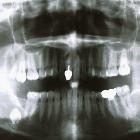Cherubismus







Cherubism has historically been considered a variant of fibrous dysplasia, but in reality is likely a distinct entity.
Epidemiology
Cherubism is a rare disorder and the precise incidence is unknown. It is inherited in an autosomal dominant pattern and has variable penetrance, with onset in early childhood (typically in the 3-4 years of age). Interestingly, penetrance is dependent on gender: 100% in males, 50-70% in females.
Clinical presentation
Clinical presentation is due to characteristic cosmetic changes in the face, consisting of:
- bilateral, usually symmetric, jaw fullness with a slight upward turning of eyes
- bilateral expansile multiloculated cystic masses with symmetric involvement of mandible and maxilla
Additionally, submandibular lymph node enlargement may also be present . The teeth in the affected regions may be loose, and tooth eruption delayed .
Pathology
Although the precise mechanism is unclear, an underlying SH3BP2 gene mutation is present in approximately 80% of cases .
Histological features are indistinguishable from a giant cell granuloma .
Radiographic features
Radiographic features consist of lucent expanded regions within the maxilla and mandible, with soap-bubble appearance. As the lesion ages, it often becomes sclerotic and may reduce in size .
Treatment and prognosis
Despite the pronounced changes, the disease stabilizes and often regresses without the need for treatment. Studies have shown a marked reduction in tumor size with imatinib, a tyrosine kinase inhibitor .
History and etymology
A cherub is a toddler or baby angel, often portrayed in art to have chubby cheeks and an upward gaze. In fact, such a divine being is more accurately called a putto, but in modern English usage the terms have become blurred, and patients with cherubism are implied to have cherub-like faces.
Siehe auch:
und weiter:

 Assoziationen und Differentialdiagnosen zu Cherubismus:
Assoziationen und Differentialdiagnosen zu Cherubismus:


